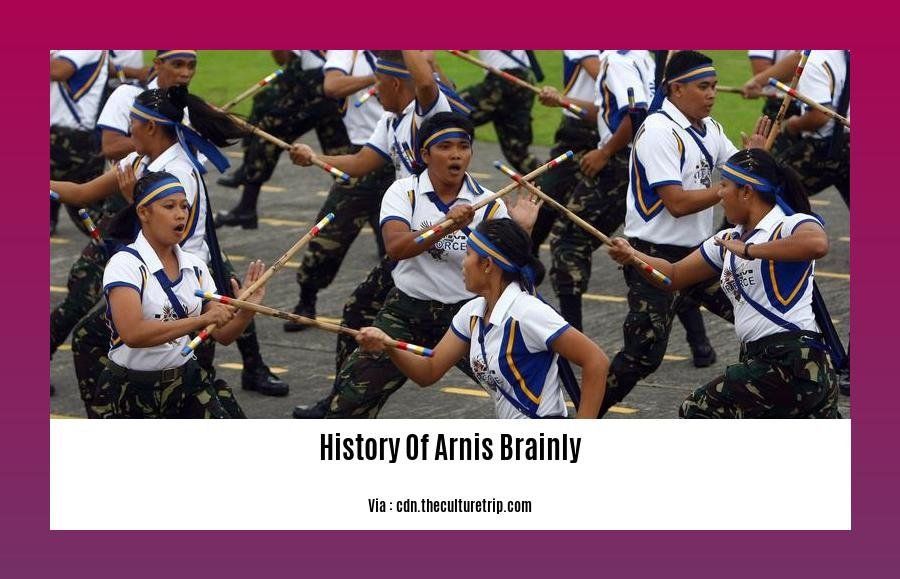– Unraveling the History of Arnis: A Filipino Martial Art Legacy [History Of Arnis Brainly] –
Key Takeaways:
- Arnis is the national sport of the Philippines.
- It is a martial art that involves swinging and twirling movements.
- Its history dates back to pre-colonial times.
- It is also known as Kali or Eskrima.
- Arnis uses rattan sticks, training knives, and safety gear in training.
- It originated from indigenous fighting techniques.
History Of Arnis Brainly

Dive into the history of Arnis, an indigenous Filipino martial art with a vibrant legacy. Let’s trace its roots, evolution, and significance in Filipino culture.
Origins in Pre-Colonial Times
Arnis roots can be traced back to native fighting techniques practiced by prehispanic Filipino tribes or kingdoms. It’s believed to have developed as a means of self-defense and warfare.
Influence of Spanish Colonization
When the Spanish colonized the Philippines in the 16th century, they introduced European fencing techniques. These influences blended with native fighting styles, enriching the development of Arnis.
Evolution and Spread
Throughout the centuries, Arnis evolved into different regional variations, including Kali in the Visayas and Eskrima in Luzon. It remained a vital part of Filipino culture, passed down through generations.
National Recognition
In 2009, Arnis was declared the de jure national sport of the Philippines. This recognition highlights its significance and contribution to the country’s cultural heritage.
Arnis Today
Arnis is a living art form, with practitioners worldwide. It is used for self-defense, sport, and cultural preservation. Its popularity continues to grow, as people discover its unique techniques and historical significance.
Key Features of Arnis
- Weaponry: Arnis often uses rattan sticks as training weapons, but also incorporates knives, swords, and other implements.
- Twirling Movements: Arnis techniques involve swinging and twirling movements, designed to disarm and incapacitate opponents.
- Respect and Discipline: Like other martial arts, Arnis emphasizes respect, discipline, and self-control.
Cultural Significance
Arnis reflects the Filipino people’s rich traditions and resilience. It showcases their ingenuity and combat skills, and serves as a reminder of their ancestral heritage.
- For a comprehensive account of the origins and development of this fascinating martial art, check out our article on the history of arnis.
- Dive into the rich history of Arnis through our article on the history of Arniston and discover its evolution over the years.
- Explore the intertwined histories of Arnis, Kali, and Eskrima in our dedicated article on the history of Arnis Kali and Eskrima.
Influence of Chinese Martial Arts on Arnis

Arnis, the indigenous Filipino martial art form, bears traces of rich cultural influences. One significant influence is that of Chinese martial arts, which entwined with native techniques to shape Arnis into the formidable art it is today.
Key Takeaways:
- Cross-Cultural Exchange: The close proximity between the Philippines and China facilitated the exchange of knowledge and techniques.
- Weaponry Influence: Weapons such as the “nunchaku” and “sai” found their way into Arnis, enriching its arsenal.
- Footwork and Mobility: Chinese martial arts emphasized footwork and mobility, which complemented Arnis’s quick and fluid movements.
- Holistic Training: Arnis adopted the holistic approach of Chinese martial arts, encompassing not just physical techniques but also mindfulness and discipline.
- Dynamic Evolution: The continuous interaction between Chinese and Filipino martial arts led to a dynamic evolution of Arnis, adapting to changing times and needs.
Citations:
- Cultural Influences on Arnis
- The Influence of Chinese Martial Arts on Arnis
Arnis as a Symbol of Filipino Identity and Resistance
Arnis, a traditional Filipino art, is more than just a martial art – it’s a reflection of the Filipino spirit. Born from the need for self-defense against foreign invaders, it became a symbol of defiance and resistance.
Arnis embodies the Filipino traits of resilience and ingenuity. Its practitioners, known as arnisadors, wield sticks and other improvised weapons, showcasing their combat skills and cultural heritage. Arnis training instills discipline, respect, and self-control, shaping individuals who embody these Filipino values.
Throughout history, Arnis has played a crucial role in defending the Philippines’ identity. During the Spanish occupation, it was secretly practiced as a form of resistance. And during World War II, Filipino soldiers employed Arnis techniques to fight against invading forces.
Today, Arnis continues to be a symbol of Filipino pride and identity. It’s taught in schools, cultural centers, and even the Philippine military, ensuring its legacy as a living testament to the Filipino spirit.
Key Takeaways:
- Arnis is an indigenous Filipino martial art that emphasizes weapon-based fighting.
- It originated as a means of self-defense and warfare against foreign invaders.
- It symbolizes Filipino resilience, ingenuity, and cultural identity.
- Arnis training strengthens both physical and mental skills, instilling discipline and self-control.
- It continues to play a significant role in Filipino culture, being practiced for self-defense, sport, and as a symbol of national pride.
Sources:
- History of Arnis Filipino
- Arnis: The Philippines’ National Sport and Martial Art
:Citation”]}’;, ” concluding
FAQ
Q1: When did Arnis originate?
A1: Arnis can be traced back to pre-colonial times, with its roots in native fighting techniques among prehispanic Filipino tribes or kingdoms.
Q2: What are the other names for Arnis?
A2: Arnis is also known as Kali or Eskrima.
Q3: What is the significance of Arnis in Philippine culture?
A3: Arnis is the de jure national sport of the Philippines, showcasing the country’s rich martial arts heritage.
Q4: What is the connection between Arnis and the Spanish colonization?
A4: The term “Arnis” comes from the Old Spanish word “arnés,” likely due to the influence of mock battles in traditional Moro-moro stage plays during the Spanish colonial era.
Q5: What is the importance of weapons in Arnis training?
A5: Arnis training typically involves the use of rattan sticks, training knives, and safety gear, emphasizing the practical aspects of combat and self-defense.












